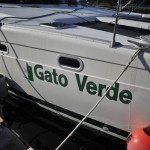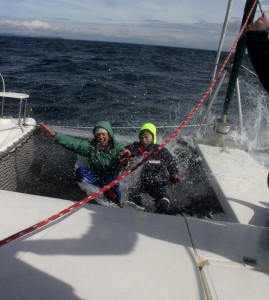Tasks at Sea
I’m happy to say we all survived 3 weeks at sea with many stories to tell! To the left is one of my favorite pictures taken so far of me and Mandy riding the waves on the trampoline along the bow of the catamaran! And yes it was cold…as you can see in my face. Before I jump too far into the 3 weeks, I’ll start by reviewing how a typical day is structured. We first get up around 7:00 a.m. every day with specific tasks. We each rotate around 4 different roles that help keep the boat in shape and organize our science activities for the day.The systems reporter measures the water level in our tank, updates the sewage level,checks the percent of biodeisel left in the tank, and records our engine run time. The navigator is responsible for the weather forecast ,strength and direction of the currents,direction of the wind, amount of time predicted to reach our destination ,and is responsible for directing the boat accordingly throughout the day.The University of Washington developed a useful online program called BIS Portal and we also use another source called Open CPN that helps us predict the timing of the currents. If you live close to shore or are interested, take a look at what the tides might be like! Here is the link to BIS Portal: http://bis_portal.apl.washington.edu/bis_portal_app.php. We also learned how to use a current atlas called the Washburn Tables that seemed to conflict multiple times with Open CPN and Bis Portal predictions. This conflict further proves the complexity behind our ocean’s dynamics! Especially within the San Juan Islands where currents have hundreds of obstacles compared to deeper ocean waters away from the coast.
The science lead has the most work out of all the roles. This person is in charge of all the science activities and helps individuals reach their particular goals. The science reporter is the person who was science lead the day before and recaps what was achieved previously through graphs or a narrative presented in front of the crew. After a science meeting presenting each update, we cast off for the day.One topic that is always on our minds no matter what our science goals are for the day is the presence of whales! If we hear that whales are around we make finding them our number one priority!
We are also learning how to efficiently stay warm without putting on too many layers and making it impossible to move. Even though its Spring its very cold on the boat, especially at night in our cabins. I think this trip will make us all appreciate  how much is readily available to us on land on a daily basis (including a heater) and be more aware of how much energy and water we are using without thinking about it! This sustainability awareness is presented in the name of our catamaran. Our captain, Todd Shuster, named his catamaran the Gato Verde.  This translates to the Green Cat in spanish. It is “green” because it practices sustainable methods and “cat” represents the fact it is a catamaran. Our class revolves around practicing sustainability when we clean using environementally friendly cleaning materials and methods,minimize water usage, run the boat with biodiesel, and use the sails as our source of speed when wind is present. This class is already making me more conscious of my actions and keeping me more organized compared to how I used to be!
This translates to the Green Cat in spanish. It is “green” because it practices sustainable methods and “cat” represents the fact it is a catamaran. Our class revolves around practicing sustainability when we clean using environementally friendly cleaning materials and methods,minimize water usage, run the boat with biodiesel, and use the sails as our source of speed when wind is present. This class is already making me more conscious of my actions and keeping me more organized compared to how I used to be!




 Twitter
Twitter LinkedIn
LinkedIn Facebook
Facebook